  |
|
|||
|
****
most recent update
|
||||
|
Kittiwakes - Lowestoft - June 2006 - ©Andrew Easton
|
BLACK-NECKED GREBE Podiceps nigricollis
One was on the sea off Kessingland on the 25th.
FULMAR Fulmarus glacialis ****
Kessingland - 1st (1 S), 3rd (1 N), 7th (1 N), 15th (2 N),
20th (1 N), 23rd (1 N), 28th (1 N, 2 S).
Lowestoft North Beach - 17th (1 N).
One was prospecting along the cliffs at Corton on the 28th.
GANNET
Morus bassanus ****
Kessingland - 1st (11 N), 2nd (3 N), 3rd (22 N,
10 S), 4th (21 N, 6 S), 5th (13 N, 1 S), 6th (9 N, 1 S), 7th (9 N, 11
S), 8th (35 N, 10 S), 9th (48 N, 6 S), 10th (13 N, 13 S), 11th (11 N,
8 S), 13th (7 N), 14th (7 N, 1 S), 15th (27 N, 1 S), 16th (4 N, 1 S),
17th (36 N), 18th (14 N), 19th (4 N), 20th (12 N), 21st (12 N, 1 S), 22nd
(3 N, 3 S), 23rd (29 N), 24th (14 N, 18 S), 25th (1 N), 26th (21 N), 27th
(26 N, 6 S), 28th (13 N), 29th (43 N, 1 S), 30th (10 N, 1 feeding), 31st
(26 N, 3 S).
Ness Point - 1st (8 N), 5th (4 N), 28th (3 N).
Lowestoft South Beach - 27th (20 N).
An adult sitting very close in on the sea at Ness Point on the 3rd appeared
to have swallowed some orange plastic string. This bird was still present
at dusk on the 4th, and appeared to have lost the string hanging from
its gape. When it flapped its wings though there was very extensive feather
loss and damage to the inner right wing. Also revealed were the mostly
black secondaries indicating it is not a full adult but probably a fourth
summer bird. Gannets seen this close inshore are unfortunately rarely
in good heath.
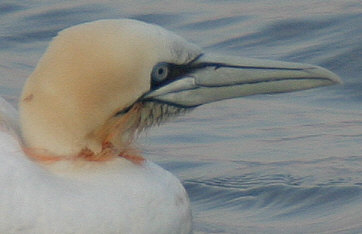  |
|
Gannet
- Ness Point - July 2006
©Andrew Easton |
CORMORANT
Phalacrocorax carbo ****
Kessingland - 2nd (1 S), 7th (1 S), 8th (1 N), 17th
(1 N), 18th (1 N), 20th (5 N), 23rd (1 S), 25th (4 N), 27th (3 N), 28th
(1 S).
Ness Point - 2nd (1 S).
GREY HERON Ardea cinerea
Two Grey Herons attempting to fly north over central Lowestoft, under
cover of virtual darkness at 22:18 on the 3rd, were vociferously and physically
challenged by the local nesting Lesser Black-backed Gulls. The assaults
were successful as both herons fairly quickly capitulated and flew back
southwards, though with gulls nesting on roofs throughout the town wherever
they went they would probably receive a similar reception!
Seven, mainly locally bred juveniles, were at Blundeston Marshes on the
6th.
MUTE SWAN Cygnus olor
Oulton Broad -14th (35).
GREYLAG GOOSE Anser anser
Oulton Broad - 14th (38).
CANADA GOOSE Branta canadensis
Nine were on Oulton Broad on the 14th.
SHELDUCK Tadorna tadorna
Kessingland - 3rd (10 N), 9th (1 S), 18th (4 N, 1 S), 19th
(1 S).
TEAL Anas crecca ****
Kessingland - 1st (3 S), 2nd (1 S), 3rd (3 S), 16th (8 S),
17th (4 S), 20th (4 S), 21st (8 S), 22nd (1 S), 30th (7 S).
GADWALL Anas strepera
A pair were at Leathes Ham on the 2nd.
Kessingland - 9th (7 S), 16th (9 S), 24th (5 S).
COMMON EIDER Somateria mollissima ****
One drifted north on the sea past Kessingland on the 29th.
COMMON SCOTER Melanitta nigra ****
Kessingland - 1st (8 N), 3rd (36 S), 4th (7 N, 23 S), 6th
(2 N, 2 S, 15 o/s), 8th (8 N), 9th (11 S), 12th (45 S), 13th (50 S), 14th
(6 S), 15th (32 S, 5 o/s), 16th (20 N), 18th (4 N), 20th (29 N, 34 S),
22nd (1 N), 23rd (1 N, 1 S), 24th (17 N, 48 S), 25th (4 o/s), 26th (5
N, 45 S, 2 o/s), 27th (1 S, 62 o/s), 28th (9 S), 29th (16 N, 12 S, 3 o/s),
30th (9 N, 2 o/s).
Ness Point - 14th (5 N).
OSPREY Pandion haliaetus
One flying northwards low over Laurel Road, Kirkley on the 23rd made up
for being a good boy and staying at home to do some gardening and decorating
(after a brief Yellow-winged Darter twitch)!
RED-FOOTED FALCON Falco vespertinus
A first summer male was seen near the harbour mouth at Gorleston at 6:37
on the 7th; it then drifted off to the south.
HOBBY Falco subbuteo
Two were hunting over crops at Blundeston Marshes on the 4th.
OYSTERCATCHER Haematopus ostralegus ****
Three were flying around over cliff top fields at Corton on the 8th.
Kessingland - 3rd (1 N, 1 S), 7th (1 S), 11th (1 S), 12th (2 S),
13th (3 N, 1 S), 17th (1 S), 19th (4 N), 20th (2 S), 21st (2 S), 22nd
(1 S), 23rd (7 S), 24th (2 N, 14 S), 25th (1 S), 26th (5 S), 27th (1 S),
29th (4 S), 30th (10 S), 31st (2 N, 1 S).
Leathes Ham - 28th (2).
Lowestoft North Beach - 30th (6 S).
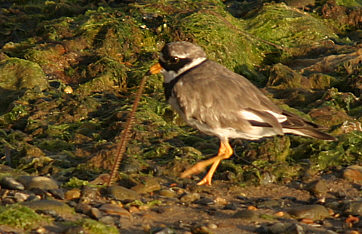 |
|
Ringed
Plover (catching dinner) - Hamilton Dock - July 2006
©Andrew Easton |
RINGED
PLOVER Charadrius hiaticula
Two were in Hamilton Dock on the 3rd, 13th and 14th.
GREY PLOVER Pluvialis squatarola ****
Kessingland - 28th (1 N), 29th (3 S), 31st (1 S).
KNOT Calidris canutus ****
Two flew south past Kessingland on the 6th, with another two south past
there on the 28th.
One very tame individual was feeding along the tideline in children's
corner on Lowestoft South Beach on the 28th despite the crowds and aircraft
noise.
DUNLIN Calidris alpina ****
Kessingland - 6th (6 S), 22nd (1 S), 23rd (4 S), 27th (3
S), 28th (2 S), 29th (12 S).
BAR-TAILED GODWIT Limosa lapponica ****
Kessingland - 9th (1 S), 11th (1 S), 27th (1 S), 29th (4
S), 30th (1 N, 4 S).
WHIMBREL Numenius phaeopus
****
Kessingland - 6th (1 S), 8th (1 S), 9th (1 S), 11th (1 S),
12th (1 S), 18th (1 S), 20th (1 S), 21st (1 N, 1 S), 22nd (1 S), 23rd
(2 S), 25th (2 S), 26th (88 S), 27th (24 S), 29th (34 S), 30th (2 S),
31st (1 S).
Corton - 8th (1 S).
Ness Point/North Beach - 17th (1 N), 30th (12 S).
CURLEW Numenius arquata
Kessingland - 1st (1 N), 3rd (6 S), 5th (3 S), 6th
(8 S), 7th (1 S), 8th (4 S), 9th (3 S), 11th (2 S), 12th (16 S), 15th
(4 S), 16th (7 S), 19th (1 S), 19th (1 S), 20th (2 S), 21st (6 S), 23rd
(12 S), 29th (1 S), 30th (6 S).
REDSHANK Tringa totanus
One was at Ness Point on the 12th, it then flew south and was then seen
on the South Beach and the rock breakwater by the South Pier.
Kessingland - 8th (1 S), 9th (1 S), 10th (14 S),
12th (1 S), 20th (1 S), 23rd (3 S), 26th (2 S).
Lowestoft North Beach - 22nd (3 S).
GREENSHANK Tringa nebularia ****
One was calling overhead over Sussex Road, Lowestoft, on the 1st.
One flew south past Kessingland on the 6th, with another south there on
the 29th.
GREEN SANDPIPER Tringa ochropus
Two were flying around calling over the marshes along the Breydon South
Wall on the 16th.
One was seen ay Kirkley Fen on the 21st.
COMMON SANDPIPER Actitis hypoleucos
One was in Mutford Lock basin along Lake Lothing on the 22nd and 31st;
one was seen at Gunton on the 23rd and one was along Lowestoft North Beach
on the 30th.
TURNSTONE Arenaria interpres ****
Ness Point - 1st (4), 7th (1).
Hamilton Dock - 4th (5), 5th (2), 14th (9), 16th (5).
Kessingland - 29th (1 S).
Lowestoft North Beach - 31st (3).
POMARINE SKUA Stercorarius pomarinus ****
One flew north past Kessingland on the 24th.
Three subadults (probably second summers) flew north together past Kessingland
on the evening of the 28th, shortly afterwards they settled on the sea
together off Lowestoft North Beach before continuing northwards a short
while later.
ARCTIC SKUA Stercorarius parasiticus ****
Kessingland - 12th (1 dark phase north), 21st (2 pale phase
north), 24th (1 dark phase S), 28th (1 dark phase o/s), 29th (2 pale phase
N), 30th (1 pale phase N).
Lowestoft North Beach - 24th (5 - 2 pale phase adults
+ juvenile south; and 2 adults, pale and dark phase lingering on sea),
30th (2 adults).
Lowestoft South Beach - 27th (3 N).
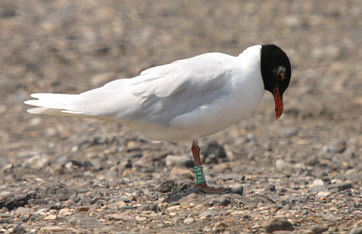 |
|
Mediterranean
Gull - Lowestoft - July 2006
©Andrew Easton |
MEDITERRANEAN
GULL Larus melanocephalus ****
One green ringed adult was with Black-headed Gulls at Links Road car park
on the 1st and at Ness Point on the 5th. A Lowestoft regular now it seems;
having spent the last two winters in Lowestoft it looks like it's back
for another already.
An adult, possibly the same as the above, flew north past Ness Point on
the 2nd.
One adult along the North Beach on the 14th could again be the same individual
as above.
One rather tatty first summer was scavenging amongst the Airshow crowds
on Lowestoft South Beach on the 27th.
One very smart juvenile was ant catching along Lowestoft North Beach on
the 28th.
One juvenile flew north past Kessingland on the 29th.
One tatty second summer-winter individual was ant catching along Lowestoft
North Beach on the 30th.
LITTLE GULL Larus minutus ****
Kessingland - 3rd (1 adult N), 7th (2 adults S), 13th(1
adult N), 21st (1 adult N), 22nd (1 S), 29th (1 S), 30th (1 N).
Lowestoft North Beach - 17th (1 adult S), 24th (1 adult),
27th (2 adults), 30th (6 adults, 2 first summers).
Gunton Beach - 28th (1).
Links Road Car Park - 31st (1).
BLACK-HEADED GULL Larus ridibundus
Increasing numbers of juveniles, such as the one pictured below, are appearing
along the coast now.
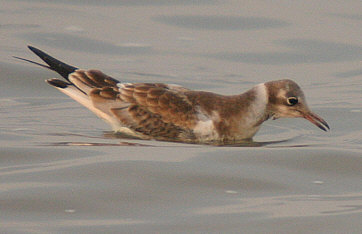 |
|
Juvenile
Black-headed Gull - Lowestoft - July 2006
©Andrew Easton |
LESSER
BLACK-BACKED GULL Larus fuscus
An unfledged juvenile was noted on a roof in Beccles early in the month,
so breeding is taking place there now as well as Lowestoft.
HERRING GULL Larus argentatus
One juvenile was making its first tentative flight south over Ness
Point on the 2nd, another was watched flying south at Corton on the 8th,
most chicks in the town seem far less advanced than this.
The local gulls soon got used to the aircraft flying around during
the two day air show along Lowestoft South Beach on the 27th and 28th.
On the 28th those on the Claremont Pier didn't even bat an eyelid during
the Harrier display!
YELLOW-LEGGED GULL Larus (cachinnans) michahellis ****
Old faithful had returned again to Lowestoft North Beach on the 30th.
This very large individual was first noted in September 1997, and so has
now been returning for ten years. As it was a full adult when first seen
it is now at least 14 years old. Last year it was first noted on July
17th so we were beginning to wonder if it would be returning this year.
KITTIWAKE Rissa tridactyla ****
Kessingland - 1st (11 N, 5 S), 2nd (1 N, 1 S), 3rd
(18 N, 3 S), 4th (11 N, 4 S), 5th (6 S), 6th (3 N, 8 S), 7th (3 N, 30
S), 8th (7 N, 28 S), 9th (6 N, 10 S), 10th (10 N, 17 S), 11th (12 N, 69
S), 12th (11 S), 13th (16 N, 28 S), 14th (9 N, 11 S), 15th (12 N, 13 S),
16th (6 N, 2 S), 17th (12 N, 1 S), 18th (5 N, 4 S), 19th (6 N, 2 S), 20th
(7 N, 28 S), 22nd (6 N, 48 S), 23rd (4 N, 48 S), 24th (24 N, 27 S), 25th
(3 N, 7 S), 26th (9 N, 56 S), 27th (5 N, 76 S), 28th (12 N, 9 S), 29th
(5 N, 19 S), 30th (1 N, 27 S), 31st (4 N, 14 S).
SANDWICH TERN Sterna sandvichensis ****
Kessingland - 1st (9 N, 3 S), 2nd (2 N, 3 S), 3rd
(13 N, 7 S), 4th (8 N, 2 S), 5th (3 N, 6 S), 6th (4 N, 6 S), 7th (1 N,
1 S), 8th (4 N, 4 S), 9th (5 N, 4 S), 11th (4 S), 13th (7 S), 15th (34
N, 7 S), 16th (9 N, 2 S), 17th (13 N, 4 S), 18th (2 S), 19th (5 N, 4 S),
20th (17 N, 8 S), 21st (2 N, 3 S), 22nd (8 N, 13 S), 23rd (12 N, 16 S),
24th (29 N, 20 S), 25th (28 N, 13 S), 26th (26 N, 24 S), 27th (19 N, 42
S), 28th (25 N, 17 S), 29th (6 N, 41 S), 30th (15 N, 22 S), 31st (6 N,
32 S).
Ness Point - 1st (3 N).
ROSEATE TERN Sterna dougalli ****
A ringed adult was perched on the groynes along Lowestoft North Beach
on the 30th was an all too rare sight in Lowestoft, but departed soon
after. An even bigger surprise was an unringed second individual on another
groyne soon afterwards; this luckily stayed around a bit longer before
departing southwards out to sea. Both individuals are pictured below.
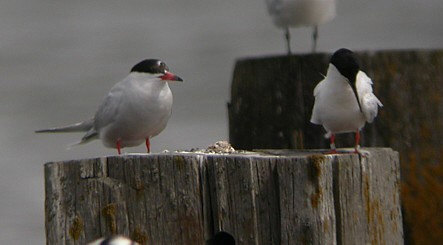 |
|
Roseate
Tern (right) and Common Tern - Lowestoft - July 2006
©James Wright |
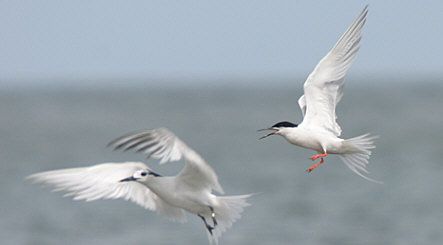 |
|
Roseate
Tern (right) and Sandwich Tern - Lowestoft - July 2006
©Andrew Easton |
COMMON TERN Sterna hirundo ****
13 were perched on the groynes along Lowestoft North Beach on the 28th.
Fledged juveniles are appearing there now along with the adults.
ARCTIC TERN Sterna paradisaea ****
One was perched on the groynes along Lowestoft North Beach on the 28th.
'COMMIC' TERN Sterna hirundo/paradisaea ****
Kessingland - 3rd (1 N, 1 S), 4th (3 N), 5th (2 N),
6th (5 N, 1 S), 7th (3 N), 8th (2 N, 7 S), 9th (3 N), 11th (3 N, 2 S),
13th (2 N), 14th (1 N), 15th (2 N), 16th (5 S), 17th (2 S), 19th (4 S),
20th (7 N, 12 S), 21st (1 N, 4 S), 22nd (4 N, 9 S), 23rd (10 N, 4 S),
24th (3 N, 4 S), 25th (5 N, 2 S), 26th (25 N, 12 S), 27th (21 S), 28th
(9 N, 19 S), 29th (5 N, 31 S), 30th (24 N, 28 S), 31st (13 N, 43 S).
LITTLE TERN Sterna albifrons ****
Kessingland - 1st (4 N, 2 S), 2nd (1 N, 2 S), 3rd
(6 N, 3 S), 4th (1 N, 4 S), 5th (4 N), 6th (2 N), 7th (1 N), 8th (4 S),
9th (2 N, 5 S), 10th (1 S), 11th (1 S), 13th (3 S), 21st (3 N, 4 S), 22nd
(1 S), 23rd (1 S), 24th (3 N), 25th (7 N), 27th (2 S), 28th (14 N, 18
S), 29th (4 N, 4 S), 30th (3 N), 31st (1 N).
BLACK TERN Chlidonias niger ****
One was seen feeding offshore at Kessingland on the 27th.
Eight were noted past Gorleston on the 29th.
One was feeding offshore along Lowestoft North Beach on the 30th.
AUK sp. Alcidae
Kessingland - 3rd (1 N), 6th (2 N), 10th (1 N),
15th (2 N).
STOCK DOVE Columba oenas
Leathes Ham - 1st (2).
TURTLE DOVE Streptopelia turtur
One was singing in Beccles Cemetery on the 13th.
[
PARROT sp.
After the Ring-necked Parakeet and unidentified red headed and breasted
Parakeet seen last month comes news of a yellow headed type Amazon Parrot
sitting on television aerials in Oulton Broad. With Red-billed
Quelea and a Weaver Finch as well there seems to have been a mass breakout
recently! ]
[ PEACH-FACED LOVEBIRD Agapornis roseicollis
Hot on the heels of the previous parrots comes a sighting of this
diminutive species at Parkhill on the 22nd. ]
CUCKOO Cuculus canorus
One was still singing at Carlton Marshes on the 4th, and a juvenile was
seen there on the 17th.
LITTLE OWL Athene noctua
One was along the disused railtrack at Corton on the 4th.
One was heard calling at Gunton on the 23rd.
One was seen at Coopers Lane, Kessingland on the 26th.
COMMON SWIFT Apus apus
A flock of 60 flew south past Kessingland on the 9th.
Several hundred ware ant catching over the sea off Lowestoft North Beach
on the evening of the 30th.
KINGFISHER Alcedo atthis
One was at Leathes Ham on the 2nd.
One was at Kirkley Fen on the 21st.
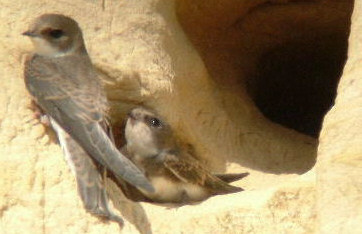 |
|
Sand
Martins - Corton - July 2006
©Derek Beamish |
SAND
MARTIN Riparia riparia ****
The colony north of Corton has about 150 active nests out of c.290 holes.
50, out of 250-300 birds present, were trapped and ringed at Corton on
the 28th, in additon one that had been ringed at Belton was also caught
there.
MEADOW PIPIT Anthus pratensis
A pair were feeding young at the North Denes on the 14th, no mean feat
considering how disturbed the area is.
YELLOW WAGTAIL Motacilla flava flavissima
One male was bathing at Corton new sewage works pond on the 1st.
At least one fledged juvenile was flying around calling over cliff top
fields at Corton on the 8th.
 |
|
Juvenile
Black Redstart - Lowestoft - July 2006
©Robert Wincup |
BLACK
REDSTART Phoenicurus ochruros
One young male was singing at Hamilton Road on the 4th and 7th, and on
the 5th there proved to be a pair feeding at least one juvenile there
(see ball of fluff above!). Probably the same bird has been heard singing
at the harbour mouth on the 12th and in Wilde Street near Ness Point on
the 14th. A second pair bred in the SLP complex as well this year.
GRASSHOPPER WARBLER Locustella naevia
One was singing at Carlton Marshes on the 17th.
Still singing in the mornings at Oulton Marshes up to the 25th at least.
COMMON WHITETHROAT Sylvia communis
Gunton Warren - 11th (2).
SPOTTED
FLYCATCHER Muscicapa striata ****
Two were seen at Beccles Common on the 1st and 2nd.
A pair were feeding four young in Normanston park on the 27th.
STARLING Sturnus vulgaris
A piebald individual was with a pre-roost gathering on the gasometer at
Ness Point on the 17th. Any relation to the white Starling present in
Kessingland last winter and spring we wonder.
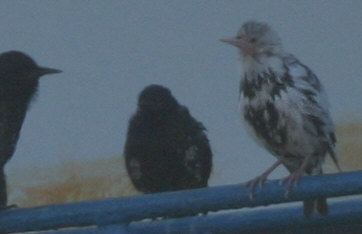 |
|
Piebald
Starling - Lowestoft - July 2006
©Andrew Easton |
GREENFINCH
Carduelis chloris
Gunton Warren - 11th (2).
LINNET Carduelis cannabina
Gunton Warren - 11th (12).
[ RED-BILLED QUELEA Quelea quelea ****
One was at a bird feeder in a Kessingland garden on the 28th, up until
the Red Arrows scared it off as they arrived for the Lowestoft Seafront
Airshow! It was back in the area again on the 30th though. Presumably
the same individual seen in June in Oulton Broad. ]
BULLFINCH
Pyrrhula pyrrhula
One was seen in Beccles Cemetery on the 13th.
YELLOWHAMMER
Emberiza citrinella
Three were at Wadling Lane, Blundeston on the 10th.
Gunton Warren
- 11th (4).
Carlton Marshes
- 17th (1).
NON-BIRD
NEWS
Grey
Seal
Kessingland - 3rd (1), 6th (1), 7th (1), 9th (1), 10th (1), 15th
(2), 16th (1), 18th (1), 21st (2), 23rd (1), 25th (1), 30th (1).
Common Seal
Kessingland - 7th (1).
Harbour Porpoise
Ness Point - 20th (2), 28th (2), 30th (2).
Kessingland - 22nd (2 feeding), 23rd (1 S), 26th (2 S), 27th (2
feeding), 30th (1 S).
Water Vole
Beccles Common - 2nd (1).
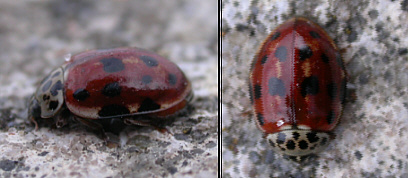 |
|
Cream-streaked
Ladybird - Lowestoft - July 2006
©Robert Wilton |
Harlequin
Ladybirds Harmonia axyridis are in evidence again this year
with one larva wandering around on a dustbin lid in Stevens Street on
the 9th and several adults seen in Belle Vue Park on the 14th. What was
initially thought to be a Harlequin Ladybird on the sea wall along Lowestoft
North Beach on the 30th proved to be a close relative, the Cream-streaked
Ladybird Harmonia quadripunctata it may have been a new immigrant
rather than locally bred, as Butterflies were certainly arriving in off
the sea during that day. The species began colonising the UK after first
appearing in
Suffolk in the late 1930's.
A Hummingbird Hawk-moth was still visiting gardens in Kessingland
up to the 19th at least. The one at Gunton feeding at Honeysuckle flowers
was seen again on the 12th, another was seen in a Gunton garden on the
17th. Much rarer though was a Striped Hawk-moth trapped in Kessingland
overnight on the 2nd. Other Hawk-moth species trapped there on the 2nd
and 3rd were Eyed, Lime, Poplar, Elephant
and Small Elephant.

|
|
Striped
Hawk-moth - Kessingland - July 2006
©Chris Darby |
On
the 1st at least three male and one female Red-veined Darters were
still at the Corton new sewage works pond. A Brown Hawker was along
the nearby disused railway line, along with a very fresh Ringlet butterfly.
The first White Admiral butterflies of the year were noted in Mutford
Wood on the 3rd.
Purple Hairstreak butterflies were noted in Gunton Wood on the 18th
and on Beccles Common on the 22nd. White-letter Hairstreaks were
seen at Beccles Common on the 12th, 22nd and 23rd after probables early
in the month. Peacock and Painted Lady butterflies were
see arriving in off the sea along Lowestoft north beach on the evening
of the 19th at least, at the same time a large immigration of Silver
Y moths was taking place.
A Brown Argus butterfly was seen at Corton new sewage works on
the 23rd, 25th and 30th. A Clouded Yellow butterfly was at Corton
new sewage works on the 25th and at Gunton orchid meadow on the 26th
and 29th.
Present at the Corton new sewage works pond on the 2nd were Emperor
(4+), Norfolk Hawker (1), Black-tailed Skimmer (numerous),
Broad-bodied Chaser (3+), Red-veined Darter (3+), Common
Blue Damselfly, Blue-tailed Damselfly, Large Red-eyed Damselfly,
and Variable Damselfly.
 |
|
Red-veined
Darter (female) - Corton - July 2006
©Andrew Easton |
On
the 23rd Beccles Marsh Trail Lakes hosted Emperor (2), Black-tailed
Skimmer (c. 6), Large Red-eyed Damselfly (30+ including several
pairs ovipositing),
Small Red-eyed Damselfly (10+), and Azure, Common Blue,
and Blue-tailed Damselflies were also present. On the marshes nearby
Emerald Damselfly and Brown Hawker were also present.
One male Red-veined Darters was still at the Corton new sewage
works pond on the 4th, with four there on the 23rd. Two males and a female
were seen at a pond at Gunton on the 11th, with three males and a female
there on the 22nd, two males were still there on the 25th. At least two
males were at Leathes Ham on the 28th.
On the 22nd a female Yellow-winged Darter was seen at the Gunton
orchid meadow near Tesco, later a male was located around the pond on
the opposite side of the road. Outside our area one was also seen on the
22nd at Reydon, near Southwold. On the 23rd at least two males were present
around the pond at Gunton, with at least one still there on the 26th.
The last in the area was seen at the same pond on July 20th 2003.
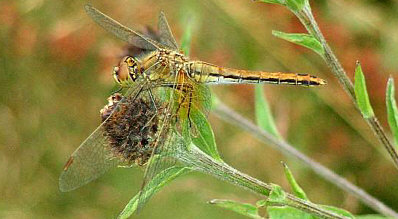 |
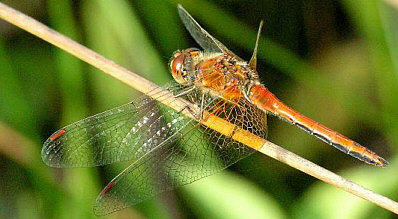 |
|
Yellow-winged
Darters (female top - male bottom) - Gunton - July 2006
©Ricky Fairhead |
The first Migrant
Hawkers were on the wing on the 22nd and 23rd.
Small Red-eyed Damselflies
are still common and widespread, being noted at Beccles Marshes, Corton
new sewage works, Gunton, and Leathes Ham at least, from the 22nd.
Present at Leathes
Ham on the 28th were Emperor (1), Southern Hawker (1), Black-tailed
Skimmer (2), Red-veined Darter (2), Ruddy Darter (2),
Common Darter (5+), Common Blue Damselfly (5+), Blue-tailed
Damselfly (1) and Small Red-eyed Damselfly (100+ males plus
a few females).
A Southern Hawker
at Carlton Marshes on the 30th was munching away on a Silver Y
with the discarded
wings falling onto the observers. It certainly won't go hungry with 1000's
of Silver Y's around at the moment.